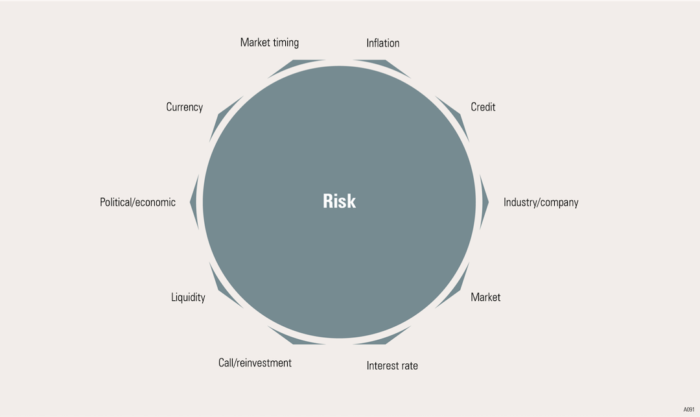“The biggest risk is not taking any risk… In a world that changing really quickly, the only strategy that is guaranteed to fail is not taking risks.” -Mark Zuckerberg
Many investors think of risk as a force to be avoided. That belief system leads many to organize a portfolio in a sub-optimal manner, making it more difficult to meet goals and objectives. Maniacal risk avoidance can only lead to implementing guaranteed or low risk strategies, and that unfortunately paves the pathway to not achieving financial goals and dreams.
That will seem odd to some, but my experience over the past five decades of working with individuals and organizations is that the unwillingness to examine and confront the aspects of risk will make it all but impossible to accomplish the dreams of a comfortable retirement, college education, and many other objectives.
When investors think of risk, they often focus on losses in capital and the tribute paid to the tax man. While both are important, these are just two of the many risks that all investors will face.
Considering risk is more than just looking at volatility and tax consequences, and investors can benefit from evaluating risk in a more robust way.
This Morningstar chart identifies ten elements of risk. The formula for a losing portfolio is to expose your wealth to one risk, or only a few risks, rather then an intelligent process of combining the various factors to enhance the probability of meeting objectives.
Unfortunately, constructing a portfolio by concentrating the type(s) of risk relies on “luck”, betting the risk you are exposed to will not be the one that brings devastating impact to your financial security.
Let’s look briefly at each risk:
Inflation: It would be easy to ignore this risk based on the low levels of inflation recently. Yet, if inflation is 2% and the return is 2% or less, the amount of purchasing power is eroding over time. When taxes are considered, an investors purchasing power is diminished.
Credit: Many look to bonds to be safer investments, yet the possibility of default needs to be a prime concern for investors. A default can produce a permanent loss of capital.
Industry/Company: Like the credit risk for bonds, equity/stock investors need to do a careful evaluation of the soundness and prospects for the company they invest in.
Market Risk: This an element of risk that get plenty of focus, especially via the financial media. Markets go up and markets go down. As discussed in Pursuing the Perfect Portfolio Design, Part 2 and Alternative Investments: How Less is More, reducing volatility, especially when withdrawals are being taken, increases effectiveness of a portfolio. It is unfortunate that many investors focus heavily on this risk and not the others, and end up with sub-optimal strategies.
Interest Rate Risk: Often ignored by investors is the impact of interest rates on a income investment. Rising interest rates will cause the value of a bond, depending on its maturity, to go down in value. Of course, rising interest rates will cause the value of the income investment to appreciate as well. This risk is especially important during rising interest rates times like we see now.
Call/Reinvestment Risk: Often the issuers of fixed income investments, such as bonds, have provision to “call” a bond. This is to the advantage of the issuer, since the possibility exists to reissue a bond at a lower rate, benefiting the borrower, and leaving the investor needing to find a new opportunity.
Liquidity Risk: Having the ability to “get your money” is very important. That said, opportunities exist to earn higher returns if liquidity is somewhat less available. As we noted in the C, B, A’s of Investing , proper planning with cash can allow opportunities to consider a broader base of investments.
Political/Economic Risk: With our 24/7 news culture, we get bombarded with events around the globe. Clearly investing needs to consider these risks to investor capital.
Currency Risk: Investing globally exposes investors to the fluctuation of each country’s valuation of currency. As with all risks, there two sides, with one being an advantage. Knowing the relative value of currency is an important aspect of managing risk.
Market Timing: Over time, moving in and out of the investment markets has proven to be a failed strategy. Yet, investors emotions drive decisions that frequently lead to bad outcomes. The worst thing that can happen is that an action appears to be the correct move. The reality is that two correct decisions need to be made on multiple occasions, and history has proven that is all but impossible to do over time.
In the next installment, the intelligent combination of risk to enhance outcomes will be explored in depth.
